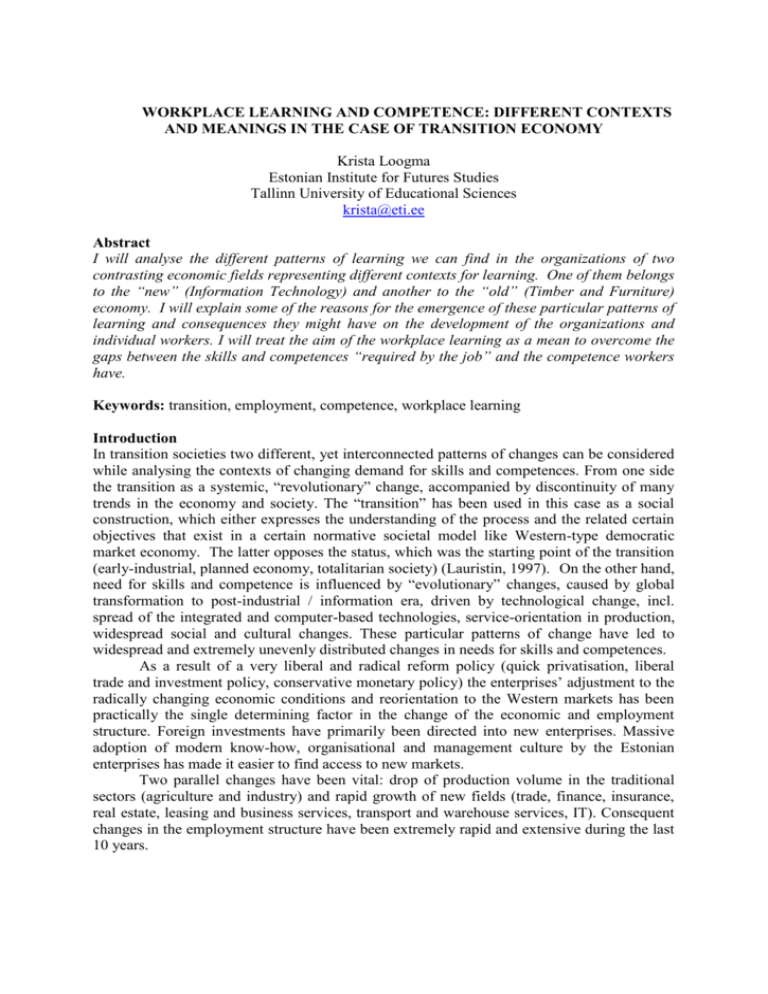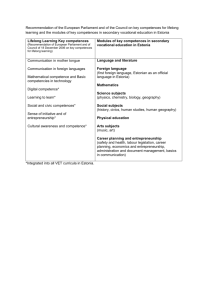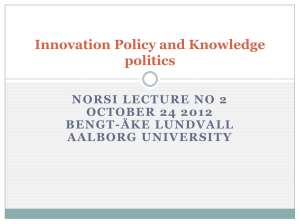Workplace learning and competence: different contexts
advertisement

WORKPLACE LEARNING AND COMPETENCE: DIFFERENT CONTEXTS AND MEANINGS IN THE CASE OF TRANSITION ECONOMY Krista Loogma Estonian Institute for Futures Studies Tallinn University of Educational Sciences krista@eti.ee Abstract I will analyse the different patterns of learning we can find in the organizations of two contrasting economic fields representing different contexts for learning. One of them belongs to the “new” (Information Technology) and another to the “old” (Timber and Furniture) economy. I will explain some of the reasons for the emergence of these particular patterns of learning and consequences they might have on the development of the organizations and individual workers. I will treat the aim of the workplace learning as a mean to overcome the gaps between the skills and competences “required by the job” and the competence workers have. Keywords: transition, employment, competence, workplace learning Introduction In transition societies two different, yet interconnected patterns of changes can be considered while analysing the contexts of changing demand for skills and competences. From one side the transition as a systemic, “revolutionary” change, accompanied by discontinuity of many trends in the economy and society. The “transition” has been used in this case as a social construction, which either expresses the understanding of the process and the related certain objectives that exist in a certain normative societal model like Western-type democratic market economy. The latter opposes the status, which was the starting point of the transition (early-industrial, planned economy, totalitarian society) (Lauristin, 1997). On the other hand, need for skills and competence is influenced by “evolutionary” changes, caused by global transformation to post-industrial / information era, driven by technological change, incl. spread of the integrated and computer-based technologies, service-orientation in production, widespread social and cultural changes. These particular patterns of change have led to widespread and extremely unevenly distributed changes in needs for skills and competences. As a result of a very liberal and radical reform policy (quick privatisation, liberal trade and investment policy, conservative monetary policy) the enterprises’ adjustment to the radically changing economic conditions and reorientation to the Western markets has been practically the single determining factor in the change of the economic and employment structure. Foreign investments have primarily been directed into new enterprises. Massive adoption of modern know-how, organisational and management culture by the Estonian enterprises has made it easier to find access to new markets. Two parallel changes have been vital: drop of production volume in the traditional sectors (agriculture and industry) and rapid growth of new fields (trade, finance, insurance, real estate, leasing and business services, transport and warehouse services, IT). Consequent changes in the employment structure have been extremely rapid and extensive during the last 10 years. Table. 1. Changes in Employment by sectors, 1991 and 2001, % Sector 1991 2001 Primary 20,4 7,1 Secondary 36,4 33,3 Tertiary 43,2 59,6 At the first stage of transition, until the period of relative stabilization before the crisis of foreign markets (“Russian crisis” in 1997), an extremely rapid and extensive reallocation of the labour force between sectors and industries occurred in parallel with the sharp increase of inactivity and emergence of unemployment (as completely new phenomenon in society) (Eamets, 2001, Loogma et al, 2002). The underdeveloped service sector expanded rapidly, relatively easily absorbing the workforce becoming vacant from the declining sectors in the process of early restructuring. High intra-sector mobility in very short time also meant that many workers took jobs in other areas without formal and/or initial training. Thus a great adaptability and flexibility was needed. Most likely the gaps in skills and competences of the workforce at the early restructuring period (until 1995) were not as big as at the end of 1990’s as the modernization processes were yet at initial stage, changes in technologies and quality standards as well as the demands of the customers were lower. One have to regard also that at the beginning of 90s “a client” was relatively new phenomenon for many enterprises and the meaning of “clients needs” was not fully recognized and considered in organizations’ culture too. There has been a lot of criticism about the ability of the workforce to adjust to the rapidly changing context of their work, to new technologies, types of products and services as well as to the changing demands of the customers. Employers stress that an education system, especially a system of vocational education and training (VET) does not succeed in offering the qualifications needed in the work context. At the same time most of the companies are not able to invest enough for training of employees. According to the statistical data from Labour Force Survey, the use of work-related training courses has been very low, constituting about 3-5% of all employed people during the last 5 years. In this context the meaning of learning in organizations, learning while working and other integrated forms of working and learning should become of crucial importance. However, there is little evidence about the patterns of work-related learning in the organizations as well as about the meaning the employers and employees attribute to different forms of learning. Two sets of qualitative data** representing the understanding of both employers and employees on the competences required and on workplace learning have been used. Estonian IT sector is expanding rapidly in terms of growth and employment, being very young both in terms of enterprises operating in the field and people working there. Generally, there is lack of regulations and professional traditions in the field. The integration of technologies and growing service component in products are the most important factors ** The empirical evidences and data provided here are the result of qualitative interviews carried out within the frameworks of two different projects: “Changes in the Employment Structure and the Content of work in Estonia” (Estonian Institute for Futures Studies, 2001) and “Identity, Mobility and Flexibility in the European Labour Market (European Commission V Framework Program FAME) changing the need for competences*. Timber and furniture sector is a traditional industry in Estonia, having long traditions and being based on one of the most important natural resource in Estonia – forest. The main structural factors influencing the demand for competences have been changes in technologies and markets and the growing share of subcontracting accompanied by increasing quality standards. In both fields the formal VET is unable to provide qualifications needed in the working life (this deficiency is nevertheless caused by different structural factors). The tripartite process of creating vocational standards is supposed to regulate the demand for qualifications in different levels of occupational groups. In the IT sector employers often say that it is not important whether the people they employ have certificate of formal education (e.g. college diploma) or not. What matters is the working experience in different IT projects and/or technical talent along with “fanatic interest” in the computer-based technologies. The deep interest in computer-based technical issues (often originating from the early school years) is supposed to be the key to hold up the continuing learning motivation. Employers rather stress the necessity of self-study and the need for “programmed self-development”. Employers prefer to employ young people directly from the “school desk” during their intern periods in companies or even hire very young talents for whom “hobby has been turned into job” from high school. The consequence for the employees is often the unfinished educational path. For the company in many cases it causes “immature personality” problems of employees. Thus the employers sometimes have to play the role of “kindergarten teachers”. This is the reason why by the understanding of the employers the suitable personality features of employees often matter more than specific skill profile. Employees have to do things they are actually not trained for and learning takes place by testing the solutions on clients. In the IT sector cases like this were quite usual at the beginning of the 90s. By the end of the 90s the situation has normalized in some extent. Still, there is enormous lack of communicative and co-operative skills of employees. Employees themselves, on the contrary, usually value certificates of formal education quite highly in many senses. There is an opinion that higher education gives “wide base” for the thinking and for further learning. Some see the diploma/certificate of higher education or other certificates (e.g. issued by big international IT tools providers) as a kind of guarantee for the future, even if their current employer does not care much about formal education certificates. Even inside the IT sector we can find different patterns of more institutionalised learning like training courses, conferences, workshops etc. the most dominating is self-directed learning while working. In this respect the significance of all forms of informal learning, including first of all learning in the project groups and in different informal networks like virtual networks and local communities of practice, learning and consulting with other “IT people”, etc. is remarkable. Among the most important are the informal communication networks (club-type communities and web-based communities), which have a significant role in the self-development process. Everyone is at the same time a teacher and a student learning from friends and acquaintances is a prominent informal way of learning, which at the same time gives a sense of solidarity. Even the changes in the field are deemed inspiring and the employees consider learning as inseparable and self-evident part of their work. Some of them experience the highly dynamic working life and “run a race to stay on line” as stressful. The price is often the overworking and lack of time for private life (Loogma, 2002). In the timber and furniture sector, from one side, there still exists a need for handicraft – type workers with competences based on wide range of good manual skills (good hands). As a rule the work motivation in the case of handcraft-type workers is * The concept of competence applied here is treated as a potential capacity of employee(s) to handle successfully certain situations or complete certain tasks (Ellström, 1997), being thus broader concept than that of skill(s) by grasping affective factors and personal traits next to different kind of skills supported by the creative nature of their work. On the other hand the more technically oriented machine operators with broad set of skills, able to complete a wide range of operations in the technological cycle are needed. The demand for the competences of skilled workers, especially in the case of operators, is characterized by employers not so much by specific skill sets as by personality traits and affective factors like responsibility, initiative, loyalty, honesty, independence, i.e. referring more to the competences than to the skills. In the employers’ discourse of a competent worker there is nevertheless also present a picture of hardworking and accurate worker being able to follow quality standards and deadlines. Some employers are talking about the lack of practical skills of employees and would rather prefer to employ people who can work without any specific training. In most cases it is nevertheless impossible because the demand for products in the sector is highly influenced by rapidly (and sometimes unexpectedly) changing subcontract works. As a rule, the companies train their skilled workers when needed, ad hoc. As for the skilled worker the client is mostly represented through qualification standards and deadlines and the share of team-work is not significant, there is an understanding that the communication competence is not important at the level of the skilled worker in this particular sector. As many skilled workers in timber and furniture sector worked earlier in the agriculture sector and later moved to the timber and furniture industry, the previous learning and working experience can have only indirect impact on the performance of the new tasks. The main form of learning is employer-directed, connected specifically with the implementation of new technology or new type of product accompanied by specific know-how. We can also find much of the apprenticeship-type learning, where a new worker is trained by another, more experienced worker or supervisor as well as self-directed learning while working in this sector. Conclusions The discourse of employers about the deficiency of required skills includes next to specific skills many aspects of competence - cognitive, affective, personality traits, communicative competences, etc. In the context of transition and resulting unavoidable rapid devaluation of skills and knowledge along with enormous lack of resources for training, the personality traits and affective factors in the “competence map” of employees seem to play an important role. The role of initial VET is rather marginal in the process of balancing demand and supply in both sectors. Learning while working, self-directed learning and other forms of informal learning at the workplace seem to play an even more significant role in overcoming the gaps in required competence in the case of transition economies than in more stable and economically and technologically more advanced countries. There is a tendency that the responsibility for the development of skills of an employee is on a large scale put on the shoulders of the employee him/herself. At present, learning while working serves as the prevailing mode of skill development. Learning environments in the IT sector can be regarded poorer than in timber and furniture. In the IT sector, learning is mainly directed by employee and supported by the ‘community of practice’ which represent one of the major learning environment. For the employees in the timber and furniture sector (representing the “old” industry), learning is mainly employer-directed and there seems to be no “community of practice” which can support the learning while working. References Eamets, R. (2001) “Reallocation of labour during transition disequilibrium and policy issues. The case of Estonia”, Tartu, Tartu University Ellström, P-E. (1997) “The Many meanings of Occupational Competence and Qualification”, in Promoting Vocational Education and Training: European Perspectives. Tamperen Yliopiston Opettajankoulutuslaitos (Ammatikasvatussarja 17), Tampere, Varastokirjasto Lauristin, M. (1997) Contexts of Transition, in Lauristin, M. Vihalemm, P (eds) Return to the Western World (Cultural and Political Perspectives on the Estonian Post-Communist Transition), Tartu, Tartu University Press, 25-40 Loogma, K. Terk, E. Kurik, S. Oruaas, J. (2001). “Muutused Eesti tööhõive struktuuris ja töö iseloomus” Tallinn , Eesti Tuleviku-uuringute Instituut Loogma, K. (2002) “Patterns of work related identity and mobility of labour”. Presentation at the FAME National dissemination workshop. Tallinn, September 27. 2002. Loogma, K. Ümarik, M. Vilu, R. (2003) “Work identities and readiness for flexibility and mobility in the IT sector (Czech Republic, Estonia, Germany, United Kingdom). Article prepared within the framework of the research project on “Vocational Identity, Flexibility and Mobility in the European Labour Market (FAME)” (forthcoming) Loogma, K. Joons, S. (2003) “Work identities and the readiness to be reliable, mobile and flexible work force” (According to cases among skilled workers and their employers in the timber and furniture industry in Estonia). Article prepared within the framework of the research project on “Vocational Identity, Flexibility and Mobility in the European Labour Market (FAME)” (forthcoming)






